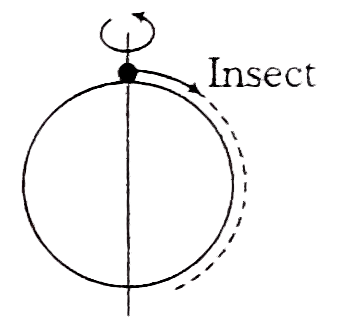Match the following columns.
∣∣
∣
∣
∣
∣
∣
∣∣Column IColumn II(A)Constant positive acceleration(p)Speed may increase(B)Constant negative acceleration(q)Speed may decrease(C)Constant displacement(r)Speed is zero(D)Constant slope of a-t graph(s)Speed must increase(t)Speed must decrease∣∣
∣
∣
∣
∣
∣
∣∣
The correct Answer is:A, B, C, D
To solve the problem of matching the columns, we need to analyze each item in Column I and determine its corresponding item in Column II based on the principles of motion in a plane.
1. Analyze Constant Positive Acceleration (A):
- When there is constant positive acceleration, the speed of the object increases over time.
- Therefore, we match A with (s) "Speed must increase".
2. Analyze Constant Negative Acceleration (B):
- Constant negative acceleration means the object is slowing down, which results in a decrease in speed.
- Hence, we match B with (q) "Speed may decrease".
3. Analyze Constant Displacement (C):
- If there is constant displacement, it means the object is not moving at all, leading to a speed of zero.
- Thus, we match C with (r) "Speed is zero".
4. Analyze Constant Slope of a-t Graph (D):
- A constant slope in an acceleration-time (a-t) graph indicates that the acceleration is either increasing or decreasing. This means the speed could either be increasing or decreasing.
- Therefore, we match D with (p) "Speed may increase" and (q) "Speed must decrease".
Final Matches:
- A → s (Speed must increase)
- B → q (Speed may decrease)
- C → r (Speed is zero)
- D → p and q (Speed may increase or Speed must decrease)
Summary of Matches:
- A - s
- B - q
- C - r
- D - p and q
- When there is constant positive acceleration, the speed of the object increases over time.
- Therefore, we match A with (s) "Speed must increase".
- Constant negative acceleration means the object is slowing down, which results in a decrease in speed.
- Hence, we match B with (q) "Speed may decrease".
- If there is constant displacement, it means the object is not moving at all, leading to a speed of zero.
- Thus, we match C with (r) "Speed is zero".
- A constant slope in an acceleration-time (a-t) graph indicates that the acceleration is either increasing or decreasing. This means the speed could either be increasing or decreasing.
- Therefore, we match D with (p) "Speed may increase" and (q) "Speed must decrease".
- A → s (Speed must increase)
- B → q (Speed may decrease)
- C → r (Speed is zero)
- D → p and q (Speed may increase or Speed must decrease)
- A - s
- B - q
- C - r
- D - p and q
Topper's Solved these Questions
- MOTION IN A PLANEBOOK - DC PANDEY ENGLISHCHAPTER - MOTION IN A PLANEEXERCISE - (C )Medical entrances gallery
32 Videos
- MOTION IN A PLANEBOOK - DC PANDEY ENGLISHCHAPTER - MOTION IN A PLANEEXERCISE - (B) Meical entrance special format questions (Assertion and reason)
19 Videos
- MOTIONBOOK - DC PANDEY ENGLISHCHAPTER - MOTIONEXERCISE - Medical entrances gallery
19 Videos
- PROJECTILE MOTIONBOOK - DC PANDEY ENGLISHCHAPTER - PROJECTILE MOTIONEXERCISE - Level - 2 Subjective
10 Videos
Similar Questions
Match the following columns.
∣∣ ∣ ∣ ∣ ∣ ∣ ∣ ∣∣Column IColumn II(A)d v/dt(p)Acceleration(B)d|v|/dt(q)Magnitude of acceleration(C)drdt(r)Velocity(D)∣∣drdt∣∣(s)Magnitude of velocity(t)Rate of change of speed∣∣ ∣ ∣ ∣ ∣ ∣ ∣ ∣∣
View SolutionTwo concentric spherical shells are as shown in figure. Match the following columns

Column-IColumn-II(A)Potential at A(p)greater than B(B)Gravitational field at A(q)less than B(C)As one moves from C to D(r)Potential remains constant(D)As one moves from D to A(s)Gravitational field decreases(t)None
View SolutionMatch the following :
Column -IColumn -II(A)Acceleration due to gravity(p)Kepler's law(B)Law of periods(q)Vector quantity(C)Orbital speed(r)Uniform near earth surface(D)Gravitational potential(s)Is nearly zero at infinity
View SolutionIn elliptical orbit of a planet, as the planet moves from apogee position to perigee position to perigee position, match the following columns
Column-IColumn-II(A)Speed of planet(p)Remains same(B)Distance of planet from centre of sun(q)Decreases(C)Potential energy(r)Increase(D)Angular momentum about centre of sun(s)Cannot say
View SolutionIf earth decreases its rotational speed. Match the following columns
Column-IColumn-II(A)Value of g at pole(p)Will remain same(B)Value of g at equator(q)Will increase(C)Distance of geostationary(r)Will decrease(D)Energy of geostationary satellite(s)Cannot say
View SolutionA solid sphere is rotating about an axis shown in figure. An insect follows the dotted path on the circumference of sphere as shown in the figure.

Column-IColumn-II(A)Moment of inertia(p)Will remain constant(B)Angular velocity(q)Will first increase, then decrease(C)Angular momentum(r)Will first decrease then increase(D)Rotational kinetic energy(s)Will continuously decrease(t)Will continuously increase
View SolutionMatch the columns
Column IColumn IIaBicuspid valvepBrainbNephronqLivercAlveolirHeartdCerebrumsKidneytLungs
View SolutionIn normal YDSE experiment, match the following two coloums.
Column IColumn IIAIn YDSE apparatus is immersed in a liquidp. fringe width will increaseBWhen wavelength of light used in increasedq. fringe width will decreaseCWhen distance between slits and screen (D) is increasedr. fringe width will remain constantDWhen distance between two slits (d) is increaseds. fringe pattern will disappear
View SolutionIf net force on a system of particles is zero. Then
Column IColumn II(A)Acceleration of centre of mass(p)Constant(B)Velocity of centre of mass(q)Zero(C)Momentum of centre of mass(r)May be zero(D)Velocity of an individual particle of the system(s)May be constant
View SolutionColumn IColumn II(A)Dimensional variable(p)π(B)Dimensionless variable(q)Force(C)Dimensional constant(r)Angle(D)Dimensionless constant(s)Gravitational constant
View Solution
